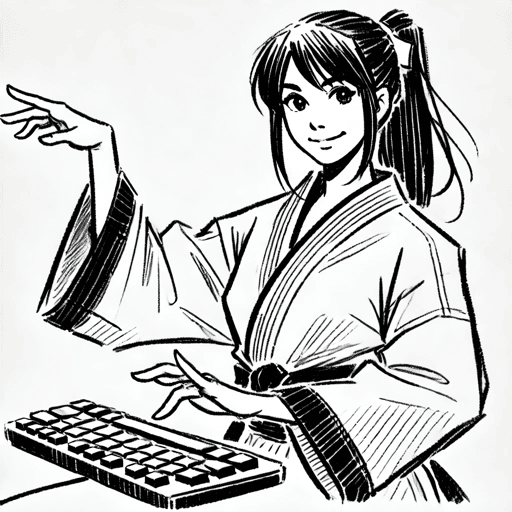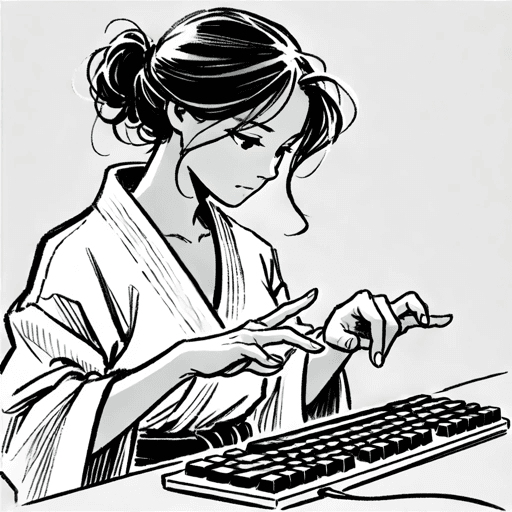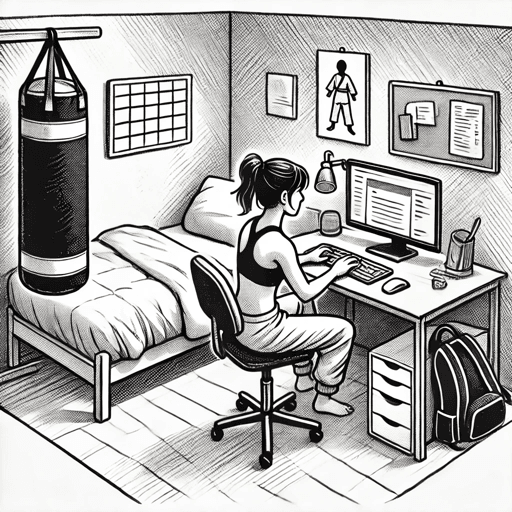Is it possible to achieve a rapid typing speed in a short time? It would be so great if it was true. However, you can set yourself another question, e.g., whether you could start dancing great salsa after 4 days of exercise, or maybe you could learn karate in 2 weeks?
Is learning touch typing similar to karate?
In what ways does touch typing resemble karate? It would seem that the two activities have nothing in common. However, we will explore if there are any similarities between them and how approaching touch typing like a martial art can add value to the learning process. Like karate, touch typing involves training your body and mind to act in unison, developing a technique that combines skill with efficiency.

Touch typing and martial arts have strict rules and patterns
The martial arts master does not swing his or her arms and legs aimlessly; rather, they move with precision, striking accurately and with strength. Typing on the keyboard also requires a kind of muscle coordination that is highly specific. The art of fast typing is not about pressing keys as quickly as possible with random fingers but rather training each finger to press specific keys. Each key has a strictly assigned finger, and pressing it with a different finger forms bad habits that can hinder your progress. Developing muscle memory with correct finger-to-key associations is essential for achieving fluidity and speed in typing, much like mastering a karate move.
Typing on the keyboard and karate require muscle memory
Isn't it obvious that both typing and karate require the use of muscles? Surprisingly, not everyone realizes that muscles "have" their own memory. If we learn typing incorrectly, we may type fast but inaccurately, as the muscles get used to incorrect patterns. Similarly, in karate, a master practices slow, precise moves many times before attempting them quickly. In touch typing, practicing slowly and accurately at first is crucial for building the right foundation. The finger-to-keyboard key assignment needs to be practiced until it becomes second nature, and then speed can be developed naturally.
Touch typing and karate involve physical exertion
Every activity that requires repeated movements also demands training and conditioning. The muscles of the hands, if not used to typing correctly, may tire over time. For instance, if someone has been typing on the keyboard for years with poor form, their muscles are not conditioned to perform correct movements. This can result in fatigue and discomfort. Typing fatigue is a common problem for many people whose jobs require extended periods of typing. Touch typing can reduce typing fatigue by emphasizing the proper use of the hands, fingers, and wrist muscles. Proper posture and hand positioning make typing more comfortable and less tiring.

You should not strain your muscles, but you need to care for your hand muscles just like you do in other sports. Prior to each session, a warm-up is beneficial. Just like in martial arts, warming up your muscles before typing can prevent injury and improve performance. Simple exercises such as wrist rotations, finger stretches, and gentle hand shaking can prepare the muscles for the repetitive movements of typing.
Developing muscle memory in touch typing and karate
Muscle memory is the ability of the muscles to remember and reproduce a particular movement or action without conscious effort. In touch typing, it involves training the muscles in the fingers to press the correct keys without looking at the keyboard. Similarly, in martial arts, it involves training the muscles to execute specific techniques, strikes, and movements without conscious effort.
In both touch typing and karate, developing muscle memory is essential for achieving proficiency. Consistent, repetitive practice of the correct technique trains the muscles to perform the movement automatically and without errors. This is essential for improving speed and accuracy in both activities. Muscle memory allows the practitioner to focus on higher-level tasks rather than the mechanics of movement. This frees mental energy for focusing on content when typing or on strategy in a martial arts scenario.
Speed and accuracy versus touch typing
When typing using the touch typing technique, muscle memory enables you to type with speed and accuracy, as the fingers automatically move to the correct keys without conscious effort. Similarly, in martial arts, muscle memory enables the master to execute techniques with speed and precision, as the muscles automatically respond to the situation and perform the right movements. Speed and accuracy in typing, like in karate, are byproducts of consistent, structured practice. Mastering speed without accuracy can lead to mistakes, which can hinder both activities.
The development of muscle memory is a gradual process that requires consistent practice, enabling the practitioner to execute techniques with fluidity and efficiency. Thanks to touch typing, you can type with speed and accuracy without looking at the keyboard or making mistakes. Muscle memory in karate allows a person to perform techniques quickly and precisely, making them a formidable opponent in a fight.
The benefits of developing muscle memory in touch typing and martial arts
Developing muscle memory in both touch typing and martial arts brings numerous benefits beyond the physical skills themselves. Both activities require mental focus, concentration, and discipline, which muscle memory helps to cultivate. In touch typing, muscle memory allows you to focus on the content of what you're typing rather than the act of typing itself. This enables faster, more efficient work, freeing mental energy for other tasks, much like the fluid motions required in karate. To put it less formally, your goal is to have more agile fingers, trained to react without thought.
In martial arts, developing muscle memory enables one to focus on the situation and the opponent rather than on executing techniques. This allows for quicker, more effective responses, freeing mental energy for strategic thinking and decision-making. In both cases, building muscle memory can elevate the practitioner's skill to a level where they can perform tasks instinctively and with greater agility.
Training place
When it comes to training in martial arts, having a dedicated space, such as a gym or dojo, is essential for success. These spaces provide a controlled environment with the necessary equipment and support for practicing techniques. A dedicated space allows for consistent, regular practice, which is crucial for developing muscle memory and physical conditioning necessary for mastery.

For learning touch typing, a dedicated space is also important. While you could learn by looking at a keyboard schema with colored keys and typing any text, having a structured environment like AgileFingers can make learning more enjoyable and efficient. AgileFingers provides a variety of exercises and learning approaches, enabling students to find methods that work best for them. It's like a gym for typing practitioners, offering structured lessons, full-text practice sessions, and typing games, making the learning experience engaging and adaptable to individual needs.
You will not get results right away
Unfortunately, learning to type quickly and accurately cannot be achieved in just a few hours or even a few days. It's more effective to spread out typing practice over time for lasting results. While progress will depend on the frequency of training, it's essential to maintain consistency without overwhelming oneself. Typing practice should be regular but not exhausting. Taking time allows for a more pleasant, sustainable learning process, as too intense a schedule could lead to frustration and burnout. Typing, like karate, is a journey where patience and persistence are key.
Conclusion
In conclusion, the development of muscle memory is essential for achieving proficiency in touch typing as well as in martial arts. Both activities require consistent, repetitive practice of the correct techniques to train the muscles for automatic and error-free movement. Developing muscle memory allows practitioners to perform with speed and accuracy, freeing up mental energy for other tasks and enhancing overall performance. Touch typing and karate both emphasize precision, discipline, and dedication, making them similar in surprising ways. Approaching typing with the same focus and methodical practice as martial arts can transform it into a skill that feels both natural and powerful.